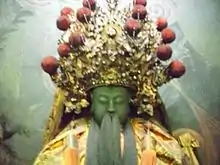Wang Ye worship
Wang Ye worship (Chinese: 王爺信仰) is a Fujianese and Taiwanese folk religion, frequently considered an aspect of the Taoist belief system. Wang Ye is particularly worshiped in Southern Taiwan.[1]

| Part of a series on |
| Chinese folk religion |
|---|
 |
The customary belief is that Wang Ye (Chinese: 王爺; pinyin: Wángyé; Pe̍h-ōe-jī: Ông-iâ; lit. 'royal lord'), are divine emissaries who tour the world of the living on behalf of the celestial realm, expelling disease and evil from those who worship them. A temple that houses a Wang Ye is generally called 代天府 (daitian fu: "palace representing heaven"), and the Wang Ye's visit is known as (Chinese: 代天巡狩; pinyin: Dài Tiān Xúnshòu; Pe̍h-ōe-jī: Tāi-thian-sûn-siú; lit. 'hunting tour on behalf of heaven'), the object of the "hunting" being disease and bad luck. Such "hunting tours" take place on a regular cycle of a set number of years, usually three years.
Origins of Wang Ye worship
Wang Ye worship stems from belief in two main categories of supernatural beings, both of which are spirits of what were once, according to legend, real human beings.
The first category of Wang Ye belief began with the legend of a kind-hearted intellectual who sacrificed himself by committing suicide in a well that contained toxic water, in order to stop the villagers from drinking the well water and thus prevented the pestilence from spreading. Therefore, to stop diseases, like pestilence, from spreading, people would pray and make offerings to those beings who committed their own lives for the public well-being. As time passed by, these great people are honored as Wang Ye and gradually became local Guardian Deities that are able to dispelling epidemic and diseases, and bestow blessings and good fortune.
The second category comprises national heroes who are bestowed with the status of Deity by the celestial order of Jade Emperor due to their heroic deeds and great sacrifices in their lives. An example is the spirit of Koxinga, thus honored for his role in defending and protecting Han Chinese against the Qing invading forces in China and the Dutch colonial forces in Taiwan.
The Wang Ye
There are many Wang Ye: some traditions claim there are a total of 360, with 132 surnames among them.
Wang Ye festivals
Wang Ye festivals take place in various parts of Taiwan, mostly in the south. They generally involve processions of gods to ward away disease and bring good fortune, and end with the burning or launch of a replica boat.
One of the grandest Wang Ye's festivals in Taiwan takes place in Donglong Temple (東港東隆宮) which is located in the city of Donggang, Pingtung County, once every three years. The 2009 festival began on October 10 and culminated in the early morning of October 17, when a wooden boat was set on fire on the beach.[2][3]
The Nankunshen Daitian Temple, considered one of the Wang Ye's founding temple, was built in 1817 and is located in Beimen, Tainan.[4]
References
- Katz, Paul R. (2011). "Royal Lords". Encyclopedia of Taiwan. Council for Cultural Affairs. Retrieved 24 February 2012.
- Kelly, Robert (9 October 2009). "Burning boats ward off plague". Taiwan Today. Retrieved 8 March 2016.
- Kelly, Robert (18 September 2009). "Temple of Fire". Wall Street Journal. Retrieved 8 March 2016.
- Yang, Ching-wu; Chen, Wei-han (15 July 2015). "Tainan temple's artwork features local celebrities". Taipei Times. Retrieved 8 March 2016.